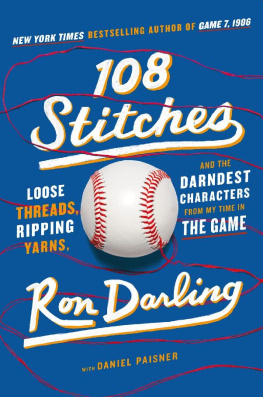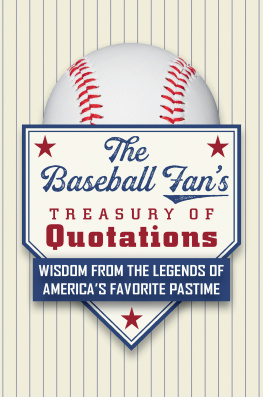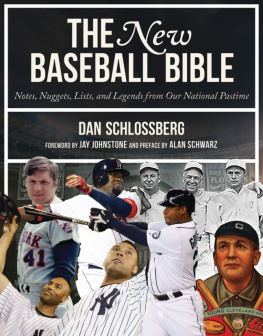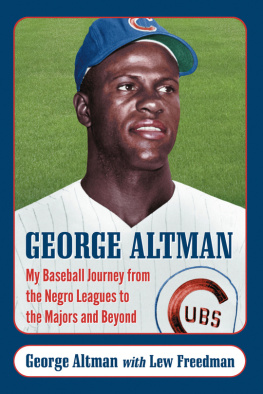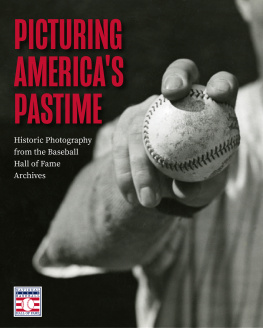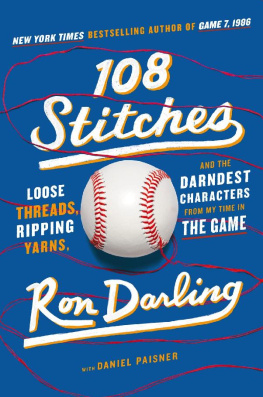When I think back on my life in and around the game, I realize its been a life lived in collaboration. Baseball is a team sport, after all, and we do what we do in concert with our teammates and coaches. The same holds true in broadcasting, where I work alongside all these tremendous professionals in the booth. And so it is in publishing. This book marks my third collaboration with my friend and co-writer, Dan Paisner, and its been one of the great partnerships of my career, on the field and off. Together, were especially grateful to Mel Berger of William Morris Endeavor and Michael Homler of St. Martins Press, who seem to believe I have something to say that caring, thinking, reading baseball fans seem to want to hear. This time out, theyve been joined in their extra efforts by a group of boundlessly talented individuals at St. Martins, including Lauren Jablonski, Joseph Rinaldi, Joe Brosnan, Paul Hochman, Ken Silver, Jonathan Bush, Joy Gannon, Jonathan Bennett, Jennifer Enderlin, Andrew Martin, Sally Richardson, and George Wittea heartfelt fist pump to you all.
A funny thing, baseball. When you spend your entire life watching it, playing it, covering it, thinking about it it becomes a part of you. It gets stuck to the bottom of your shoe like a flattened packet of Guldens pressed to the concrete steps of a section of bleacher. And then it stays with youyou look up one day and you realize youve been trailing a fine film of mustard with every step.
A lifetime in the gamemy lifetime in the gameleaves a certain trail. Better, a certain footprint. And in this way I have walked alongside every athlete who has ever put on a uniform, every coach or manager who ever sat in a big league dugout, every fan who ever played hooky from work or school and sat in the stands for a midweek day game.
Were all rounding the same bases.
This well-trodden path leaves me thinking, more than forty years after I left home for the wilds of New Haven, Connecticut, to pitch for a Yale baseball team that had once been captained by a left-handed first baseman named George H. W. Bush, who led the Elis to appearances in the first two College World Series, and had once been coached by the legendary Smoky Joe Wood, who had once been a teammate of the great Babe Ruth on the 1915 World Series Champion Boston Red Sox, who had once reportedly hit a ball over the center field Green Monster440 feet in his time. Indeed, the thru-line that runs through our national pastime can sometimes seem to stretch a country milethe combined length, not incidentally, of all those wool and cotton strands used to wrap the cushioned cork center of an official major league baseball, onto which those of us in the game might find the six degrees of separation that connects every player whos ever put on a big league uniform.
(Also not incidentally, that country mile is the distance sportswriters used to ascribe to the mighty home runs off the bat of the mighty Babe, to whom I am now inexorably connected, as I have shown.)
Upon further thought, it occurs to me that the intertwining of the collected stories of the game is a much richer, much more poetic metaphor than that flattened mustard packet, so Ill be going with this one, here on in.
Consider the baseball: that cushioned cork center, wrapped tightly with four-ply gray wool, topped by a three-ply tan wool, a three-ply gray wool, and then a thin poly-cotton thread, all of it held together by two cowhide covers, hand-stitched with 88 inches of waxed red thread. For a guy like me, who made his living on the mound, those 108 raised stitches that give the ball its seams were where the game lived and breathed and danced. Let us not forget, its these slight imperfections and variations in the stitching that catch the air and allow the ball to move this way and that, up and down, left and right. The slider, the two-seamer, the curve, the cutter, the sinker without those imperfect stitches, hand-sewn in about five minutes by Rawlings workers using two specially designed needles, the ball would be a precise sphere, and all the ways a pitcher has been taught to spin and toss a baseball would fall away. The ball would behave differently, as it traveled from the mound to the platemeaning, it would behave. (Or, not, which would in turn correlate to your time in the bigs.)
And so Ive come to look on the baseball as a symbol for the game itselfbecause, alas, weve been knitted together by our time in the game, we fans and players alike, and as I was casting about for a conceit to stitch together a book of reminiscences I realized there was room on the baseball bookshelf for such as this. Oh, there have been some wonderful, yarn-spinning accounts from former ballplayers; behind-the-scenes looks at locker room and front office shenanigans from longtime baseball beat writers; historically based novels that help us to connect the dots from baseball past to baseball present. But Id yet to come across a collection of variously connected anecdotes spun from the career of a baseball liferso I figured, Hey, may as well write one. Why? Because as the game changes I find myself reaching for ways to remind myself that it is also holding fast to its long-held traditions and time-honored characters, and because Ive found over the years that when Im swapping stories with friends, one tale often leads to another. The memories dip and swerve, like the arc of a cut fastball. They brush you back and set you on your heels and leave it so youre not quite sure whats coming. Thats the feeling I want to bring across in this book. Pull on one thread, and another one starts to unravel and another one after that.
Perhaps an illustration is in order. In 1982, at my first major league spring training camp, I spent a lot of time with Dick Allen, one of the most feared sluggers in the game for much of my growing up. He was the NL Rookie of the Year in 1964 for the Philadelphia Phillies, when he was known as Richie Allen, and for the longest time he was one of my fathers favorite players, so I started rooting for him as well. He was the American League MVP for the Chicago White Sox, in his first year in the league, when he started asking sportswriters to refer to him as Dick, which was what hed been called by friends and family his entire life, saying that Richie was a little boys name.
Ten years later, I was invited to Pompano Beach as a member of the Texas Rangers, and Mr. Allen, as I called him, was a member of the coaching staff. He took a liking to mealthough, frankly, I found him a little intimidating. (He scared the plain crap out of me, if you must know.) Mr. Allen asked me what I wanted to get out of my time in camp. I said I was hoping to earn the fifth spot in the rotation. He laughed. And laughed. Like it was the funniest thing hed ever heard. He pointed to Jon Matlack, whod been a member of the New York Mets legendary pitching staff in the early 1970s, who had a guaranteed contract, and suggested the fifth spot in the rotation was already spoken for by him. Didnt matter how I pitched. Didnt matter how Jon Matlack pitched. Mr. Allen said, Theyre gonna ship your ass to Triple-A, brother. Just you wait and see.

